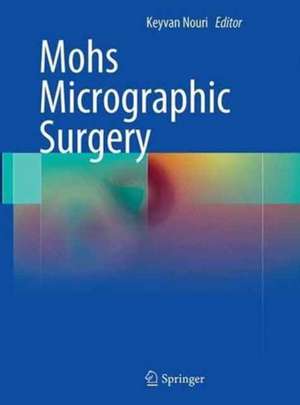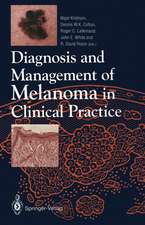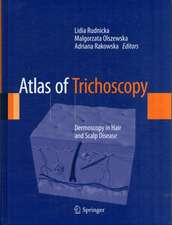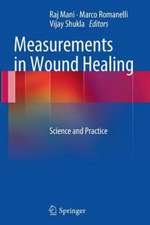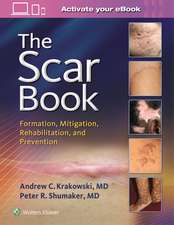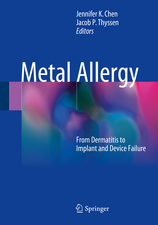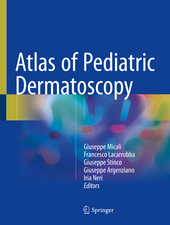Mohs Micrographic Surgery
Editat de Keyvan Nourien Limba Engleză Paperback – 23 aug 2016
| Toate formatele și edițiile | Preț | Express |
|---|---|---|
| Paperback (1) | 1095.21 lei 38-44 zile | |
| SPRINGER LONDON – 23 aug 2016 | 1095.21 lei 38-44 zile | |
| Hardback (1) | 1644.30 lei 3-5 săpt. | |
| SPRINGER LONDON – 7 mar 2012 | 1644.30 lei 3-5 săpt. |
Preț: 1095.21 lei
Preț vechi: 1152.86 lei
-5% Nou
Puncte Express: 1643
Preț estimativ în valută:
209.57€ • 216.20$ • 174.89£
209.57€ • 216.20$ • 174.89£
Carte tipărită la comandă
Livrare economică 22-28 martie
Preluare comenzi: 021 569.72.76
Specificații
ISBN-13: 9781447171522
ISBN-10: 1447171527
Pagini: 563
Ilustrații: XXI, 563 p. 245 illus., 229 illus. in color.
Dimensiuni: 193 x 260 x 25 mm
Greutate: 1.06 kg
Ediția:Softcover reprint of the original 1st ed. 2012
Editura: SPRINGER LONDON
Colecția Springer
Locul publicării:London, United Kingdom
ISBN-10: 1447171527
Pagini: 563
Ilustrații: XXI, 563 p. 245 illus., 229 illus. in color.
Dimensiuni: 193 x 260 x 25 mm
Greutate: 1.06 kg
Ediția:Softcover reprint of the original 1st ed. 2012
Editura: SPRINGER LONDON
Colecția Springer
Locul publicării:London, United Kingdom
Cuprins
Chapter 1: Historical Perspective of Mohs Micrographic Surgery.- Section I: Fundamentals of Mohs Micrographic Surgery.- Chapter 2: General Indications for Mohs Micrographic Surgery -Tumor Location (high risk anatomical location; tissue conservation priority) -Tumor Size -Deep Structure Involvement -Recurrent Tumor -Positive margins after surgical excision -Tumor type/histological differentiation -Irradiated skin.- Chapter 3: Pre-operative Evaluation.- Chapter 4: The Mohs Micrographic Surgery Operative Room Set-up.- Chapter 5: Anesthesia Considerations: Local versus Regional.- Chapter 6: Surgical Anatomy for Mohs Micrographic Surgeons.- Chapter 7: The Fixed-Tissue Mohs Micrographic Surgical Technique -Mapping -Instrumentation and sutures.- Chapter 8: The Fresh-Tissue Mohs Micrographic Surgical Technique -Mapping -Instrumentation and sutures.- Chapter 9: Special Considerations for Mohs Micrographic Surgery in Organ transplant recipients.- Chapter 10: Mohs Micrographic Surgery in Ethnic Skin.- Chapter 11: Mohs Micrographic Surgery and Genodermatoses.- Chapter 12: Nursing Interventions.- Section II: Laboratory Processing.- Chapter 13: Histopathology Laboratory Set-up and Necessary Instruments.- Chapter 14: Tissue Specimen Transport and Initial Processing.- Chapter 15: Cryostat Preparation of Slides.- Chapter 16: Staining Preparation of Slides.- Chapter 17: Histopathologic Interpretation of Mohs Slides.- Chapter 18: Tissue Specimen Documentation/Record-Keeping/Storage.- Section III: Mohs Micrographic Surgery by tumor and site.- Chapter 19: Basal Cell Carcinoma -Introduction -Basic epidemiology -Subtypes (Clinical Presentation, Histopathology, Indications for MMS, Reported cure rates à for each subtype).- Chapter 20: Squamous Cell Carcinoma.- Chapter 21: Melanoma.- Chapter 22: Dermatofibrosarcoma protuberans.- Chapter 23 Microcystic adnexal carcinoma.- Chapter 24 Atypical fibroxanthoma/ Malignant fibrous histiocytoma.- Chapter 25 Extramammary Paget’s disease.-Chapter 26 Leiomyosarcoma.- Chapter 27 Merkel cell carcinoma.- Chapter 28 Adnexal / Adenocystic carcinomas (Eccrine porocarcinoma, Sweat gland carcinoma).- Chapter 29: Sebaceous gland carcinoma.- Chapter 30: Eyelids.- Chapter 31: Nails.- Chapter 32: Genitalia.- Chapter 33: Deep Structures: Mucosa, Fat, Muscle, Nerve, Cartilage, Bone.- Section IV: Pitfalls of Mohs Micrographic Surgery.- Chapter 34: Histopathological pitfalls of Mohs.- Chapter 35: Complications of Mohs Micrographic Surgery -Bleeding -Nerve Damage -Cardiovascular Events -Drug Reaction/Toxicity/Allergy/Bacterial prophylaxis -Wound Infection/Infective seeding of prosthetic devices/Bacterial endocarditis.- Section V: Reconstructive and Adjuvant techniques.- Chapter 36: Eyelid Reconstruction after Mohs Micrographic Surgery.- Chapter 37: Flaps.- Chapter 38: Skin grafts.- Chapter 39: Complex Closures.- Chapter 40: Prosthetic rehabilitation.- Chapter 41: Adjuvant therapy after Mohs Micrographic Surgery effudex, Aldara, radiation, etc.- Section VI: Training and Regulations in Mohs Micrographic Surgery.- Chapter 42: Training and certification for Mohs micrographic surgery.- Chapter 43: Office Practice for Mohs Micrographic Surgery (ancillary).- Section VII: International Perspective of Mohs Micrographic Surgery.- Chapter 44: South America, Africa, Europe, Asia, Australia.- Section VIII: Patient Safety and Medicolegal Issues.- Chapter 45: Information for Patients and Safety Considerations.- Chapter 46: Ethical Issues regarding Mohs Micrographic Surgery.- Chapter 47: Medicolegal Issues regarding Mohs Micrographic Surgery.- Chapter 48: Psychological Issues regarding Mohs Micrographic Surgery.
Textul de pe ultima copertă
The incidence of skin cancer is 3.5 million per year and accounts for more than fifty percent of all cancers combined, the majority of which are basal cell and squamous cell carcinomas. Mohs surgery has become the treatment of choice for certain basal cell and squamous cell carcinomas and other cutaneous tumors, with a high cure rate and low recurrence rate. Physicians in all of the major disciplines of medicine will encounter patients with cutaneous cancers whom have undergone Mohs surgery or may need it in the future.
Mohs Micrographic Surgery has been written to serve as a tool to build a foundation of the fundamentals of Mohs surgery. Each chapter is easy to read, with summary boxes of all the major points. The chapters are written by world-renowned physicians in their respective specialties. Overall, the reader will enjoy an up-to-date, reliable source of information on all important aspects of Mohs surgery, and will obtain a detailed understanding of this surgery, which will greatly benefit patient care.
Mohs Micrographic Surgery has been written to serve as a tool to build a foundation of the fundamentals of Mohs surgery. Each chapter is easy to read, with summary boxes of all the major points. The chapters are written by world-renowned physicians in their respective specialties. Overall, the reader will enjoy an up-to-date, reliable source of information on all important aspects of Mohs surgery, and will obtain a detailed understanding of this surgery, which will greatly benefit patient care.
Caracteristici
Comprehensive textbook, covering all main aspects of procedure means the reader will be able to put into practice the acquired knowledge The more expertise in doing this procedure the better results the physician will accomplish Updated and informative textbook that will provide a better understanding of this procedure
